Dilli Haat, opposite INA Market, is my usual go-to place when I want to buy ethnic gifts for friends and family. An added attraction, as far as I and my family are concerned, is that Dilli Haat offers good food. Not fancy food, but more often than not, delicious—and, a boon for people like me, who don’t much care for the usual Punjabi-Mughlai fare that seems to pass for ‘Indian’ in Delhi—an opportunity to savour some of India’s less well-known cuisines.
I’ve been going to Dilli Haat (and eating there) for years now. Invariably, though, I end up eating at just a couple of food stalls: the Maharashtra one, for example, which boasts of brilliant sabudana khichri, sabudana vada, thalipeeth, and more; and the Meghalaya one, which serves up what we feel is the very best thukpa this city has to offer. Besides a totally addictive doh neiong, pork cooked in a gravy based on black sesame seeds.
This past year, I decided to do something different. I decided, every time I visited Dilli Haat, I would try something new, something I hadn’t eaten before. Or, at least, something I hadn’t eaten at Dilli Haat before. And that I would document what I particularly liked. Here goes, then: five eclectic meals at five different food stalls.
1. Non-vegetarian thali and litti-chokha thali at Bhoj Bhaat. Bhoj Bhaat seems to be one of the most unfrequented of the food stalls at Dilli Haat. Tucked away beside the Odisha stall, and in close proximity to the more popular Manipur Stall, this is one of the few stalls which seems to have mostly retained the authenticity of the food it serves: it hasn’t fallen prey to the temptation of momos, chaat, and parathas. Instead, the menu rejoices in stuff like sattu, chana dal, moori, and more. There’s lots here to please the palate, but both my husband and I decided we’d opt for thalis. One biggie, the Bhoj Bhaat non-vegetarian thali, and a smaller one, the litti-chokha thali. Both to be shared.
While we waited for our food to arrive, our waiter brought over a quarter plate with some complimentary goodies: three vegetable pakoras, a roasted papad, and little deep-fried, chocolate-coloured morsels of something I couldn’t identify, but was beautifully crisp and mildly nutty in flavour.
Within a few more minutes, the litti-chokha thali had arrived. Litti consists of large balls (about the size of a small orange) of ghee-kneaded dough, stuffed with a lightly spiced mix of sattu (basically, a blend of ground lentils, including chickpeas). Rather like the Rajasthani baati, the litti is cooked in hot coals till it’s all golden-brown on the outside, cooked on the inside. It’s then served with two main sides: chana dal, and chokha, rather like a baingan bharta—smoked aubergines cooked with onions, tomatoes, and in this case, a little boiled potato.
A roasted papad, a little bit of very rustic salad (thickly cut raw onion and mooli), a bowl of very tart yoghurt, some mouth-puckering sour and hot (but very good) pickled amla, and a trio of chutneys—a sweet tomato one; a sweet-sour tamarind one; and a fiery green chilli one—comprised the rest of the thali. Not unmanageably huge, but rather too dominant in sourness, so much so that I ended up leaving half my bowl of yoghurt, most of the chutney, and half the pickle. The dal was all right, not brilliant; and the dough covering of the litti had the look and texture of something that hadn’t been kneaded or cooked long enough. The chokha, however, was delicious. This was, overall, an okay thali.
The Bhoj Bhaat non-vegetarian thali, much larger and more interesting, was also generally better. This came with a few options included. You could choose between dal puri and sattu paratha (we chose sattu paratha); between chicken curry and mutton curry (we chose mutton); and between the three ‘sabzis of the day’, which—on the day we visited, happened to be potato with parwal, potato with cauliflower, and potato with jackfruit (we chose the potato and cauliflower).
This thali arrived five minutes after the litti-chokha thali, and (to our surprise) included not just a bowlful of the aloo-gobhi sabzi we’d ordered, but also a bowl of aloo-parwal (were there no takers for it? Had our waiter seen the rueful expression on my face when my husband picked the aloo-gobhi instead?) The aloo-gobhi was all right (neither sabzi was too spicy, so that was good), but the aloo-parwal was really nice: perfectly cooked, with the parwal still having a bit of bite to the skin, while the potato was tender.
The two sattu parathas were fabulous. The filling was generous, well-flavoured and delicious enough to allow the paratha to be eaten on its own (and the paratha wasn’t greasy). The mutton curry, while quite virulent-looking (it was a deep, dark brown that screamed ‘Spice!’), actually tasted good. The two pieces of meat, though, were bony and with too little flesh on them.
Like the litti-chokha thali, this one too had the chunks of raw onion and mooli; in addition, it had a bowl of a very light raita, mostly just delicately spiced yoghurt with an odd bit of boondi floating here and there. Unlike the other, more sparse thali, this one also had a dessert: a bowl of delicious makhaane ki kheer (for the uninitiated, makhaanas are lotus seeds). The lotus seeds were faintly chewy and spongy, the kheer chilled and sweetened just to the right extent. My sister, who cannot abide grated coconut atop desserts, would probably have thrown a fit at the garnish, but we didn’t mind it.
The litti chokha thali at Bhoj Bhaat costs Rs 120 and is good if you’re not frightfully hungry. If you do want a substantial meal, the full thali is recommended. The non-vegetarian one costs Rs 350. These rates are all-inclusive; no taxes or service charges are added on separately.
2. Naga special thali (pork) at the Nagaland Food Stall. The Nagaland Food Stall, sandwiched between the Maharashtra Food Stall and the little café run by Navdanya, has an array of (largely non-vegetarian) dishes, all the way from the sort of stuff most Dilliwallahs associate with the North-East (read: momos), to relatively little-known (to Dilliwallahs, at least) foods like akhuni and anishi. We were four of us—my husband and I, and my parents—and when I decided I wanted to eat the Naga special thali (pork), the other three also picked the same thing.
The special thali is also available in other versions—chicken, for example. The pork one costs Rs 320 per thali, and came in a large steel thali, with a generous helping of steamed rice, along with a row of steel bowls, each with its own dish. Besides that, there were two types of chutneys: a really spicy one based on ground green chillies, and a rather more interestingly chunky one made from whole dried prawns, which I loved.
The little bowls contained the main dishes. There was a dal (yellow moong, I think, though I couldn’t be absolutely certain), cooked with some tomato, mild yet flavourful. There was a very light and refreshing dish of greens: mustard greens cooked with ginger juliennes in water, with a little salt. Really. Just that: fresh, incredibly light, and so very healthy.
Up next was probably the most unhealthy part of the meal, the pork curry for which this particular thali is named. The meat could have been slightly more tender, but that, I think, was less a problem of the extent to which it had been cooked and more to do with the quality of the ingredient. At any rate, it wasn’t outright tough. Three largeish pieces of pork, lots of meat and lots of fat with rind, in a deep red gravy that looked more fiery than it turned out to be—which was fine with us.
Last up, there was a mixed dry vegetable dish, a predominantly bitter mélange of kundru (ivy gourd) and karela (bitter gourd), cooked with what seemed to be no spices except salt and possibly a little chilli. A good palate cleanser, really.
On the whole, a very likeable meal. My husband thought the pork too fatty, but the rest of us were happy with it. And with our meal in general.
3. Combo thali at Bijoli Grill. Just opposite the Nagaland Food Stall, and separated from it by a row of potted plants, is the West Bengal food stall, run by Bijoli Grill (who, by the way, also have a restaurant at the West Bengal Bhavan in Delhi, besides other outlets in other cities).
The menu here at the Dilli Haat stall is divided into two sections: the typically Bengali one, which features old favourites like Mughlai paratha, kosha maangsho, an array of fish/seafood dishes, etc; and a Chinese one, probably a nod to the typical ‘Calcutta Chinese’. I wasn’t interested in the latter; and I wanted more than just a couple of dishes of the former, so the best bet seemed to be a set meal. Bijoli Grill offers three types of thalis, of which the combo thali is available only on Saturday and Sunday. From its description on the menu, this sounded the most appealing to me, so that was what I ordered.
The combo thali—which takes 20 minutes to be served up—came in an impressive-looking brass platter, with matching katoris. In the centre was a large, neat mound of polao, the Bengali version of pulao: turmeric-tinted rice dotted with peas and raisins, light and fresh. Next to the polao, arranged in a tidy semi-circle, were four crisp golden luchis, the puri-like (but made of maida, not atta) deep-fried breads that are a staple of Bengali cuisine. A fried papad topped off the polao.
There was a generous (and absolutely delicious) fat circle of deep-fried aubergine (baigun bhaaja, one of my favourite Bengali vegetarian dishes); fish fry (a crumb-fried fillet of fish, the fish being first marinated in a lightly spiced marinade); chholar dal (chana or split chickpea dal, cooked with cardamom and other spices, and lightly sweetened); kosha maangsho (a fabulous curry of goat meat, rich but not too heavy), and a sweet and sour chutney dotted with raisins and chopped dates. For dessert, there was a small plastic bowl of the rice pudding known as payesh.
Nothing in the thali was outright bad, though I’ve had better chholar dal and better fish fry. The payesh I found to be a little too sweet (and I prefer my payesh to be made with jaggery; this was plain old refined white sugar). On the whole, though, this was a meal worthy of being repeated. A trifle expensive, perhaps (Rs 500 per thali), but good.
4. Rajasthan special thali at the Rajasthan Food Stall. Traditional Rajasthani food is not unknown in Delhi, what with the odd Marwari restaurant here and there—and the fact that just about everybody has at least heard of (even if they’ve never eaten) daal-baati-churma, ghevar, laal maas, et al. The Rajasthan Food Stall at Dilli Haat is tucked away in one of the more cramped parts of the complex, near the Jammu and Kashmir, Odisha, Meghalaya, and Tripura stalls. The menu has a very wide selection of dishes—all of them vegetarian—to choose from. There are the rather more pan-North Indian dishes, like the paneer or aloo parathas, as well as the more typically Rajasthani specialties, like the daal-baati-churma and the pyaaz kachori. And they have a special thali.
We ordered this one time, and were well satisfied with it. Arranged around a generous heap of steamed rice in the middle of the platter were fresh salad (the no-dressing type: just sliced radish, cabbage, and plenty of onions); a tablespoonful of fiery red garlic chutney; and, on top of the rice, one bajre ki roti and one missi roti, both gloriously hot and dripping with ghee. Also nestled beside the rice was the baati: a small, laddoo-sized ball of atta kneaded with ghee, salt and a few spices (coriander seeds were what I could identify) and baked in hot coals.
Around that were metal bowls (and not teensy-weensy ones, either) with the curries etc that went with the breads and rice. There were two relatively spicy dishes: a dryish vegetable curry of potatoes, green capsicum and tomatoes; and a gatte ki curry, with the gatte made of a spiced chickpea dough, rolled into cylinders and fried before being added to the curry. These weren’t so hot that they’d rip your tongue out; but, in comparison to the others, they certainly had more chilli.
The rest of the bowls contained, in order: a thin, not terribly memorable kadhi with two little pakoras; a fabulously simple but delicious dal that perfectly accompanied the baati; and a very plain raita, of chopped onions and tomatoes in yoghurt whisked with salt. On the side was a touch of the desert: the dish known as ker-sangri, a dry vegetable dish made of a desert bean and a pod, cooked with spices. This one was so-so (it had more spice than anything else), but on previous occasions at the same food stall, I’ve had excellent ker-sangri, so I’m guessing this was an off-day.
For dessert, there were two sweets: a bowlful of sinful ghee-laden moong daal halwa, and a lovely coconut laddoo, both of which I loved (and that’s saying a lot, since I tend to find most North Indian sweets overly sugary).
We paid Rs 340, inclusive of taxes and a tip, for our thali (the price of the thali itself is Rs 300). Considering this included extra rotis (the waiter came by himself, to ask if we wanted more rotis) and that the food was enough for two people to eat, I’d call this a steal. A must-do if you like Rajasthani food, and don’t mind being hemmed in a bit if you go at peak hours.
5. Fish thali at the Assam Food Stall. The Assam Food Stall sits right next to the Punjabi Rasoi, which means the competition, in a city that thrives on its chhole-bhature and tandoori chicken, is pretty stiff. Much of the menu at the Assam Food Stall, therefore, tries to counter that with another set of Delhi staples: momos, thukpa, and loads of Indian Chinese dishes.
Fortunately, they also have a small section of rather more traditional Assamese dishes. Happening to come by here right after a session of the Delhi Literature Festival, I decided to try out the Assam Food Stall, since I’d never eaten here before. Giving the Chinese and Tibetan-derived dishes a miss, I had a look at the selection of thalis: egg, chicken, and fish. No problems deciding, there: I am a fan of fish, so fish it was. And if you’re going to be eating Assamese food, fish is the way to go, isn’t it?
The waiter took my order and while I sat waiting and reading a book I’d brought along, I could hear—beyond the woven bamboo façade of the stall—the loud sizzle of fish being slid into a pool of hot oil. Another ten minutes or so, and my meal arrived.
Arranged on a small brass thali, around a huge heap of plain rice, were four bowls.
The largest, the highlight of the thali, was the fish curry. At first sight, this looked like a watery potato curry, but some poking about unearthed the flat piece of submerged fish. I am no good at recognizing fish, but this one was not one of the very bony ones so beloved of the Assamese and the Bengalis. It had loads of flavour (and lovely crisp-fried skin) and few—and large—bones. What I also liked a lot was the curry itself. The potato, broken roughly; the tartness of the gravy, the fact that it wasn’t hot at all.
Beside the fish curry was a smaller bowl, with mixed vegetables—I could identify potatoes here, and some green beans, but the rest seemed to be a pretty much overcooked, unidentifiable mass. Forgettable.
Up next, the dal. This appeared to be moong, lightly flavoured with some souring agent. Warm, gentle, soothing. Not the sort of dal that’ll blow your socks off with its flavours, but solid comfort food, especially just eaten with the rice and a little bit of the fish curry.
Last, but by no means the least, the pitika. A potato mash with a difference, pitika has the boiled potato mixed with salt and chopped onions, and with raw mustard oil swirled in. I’ve had pitika before, and am very fond of it—mostly because of that mustard oil. The people at the Assam Food Stall could have chopped the onion finer, but other than that, I had no complaints: this was the type of pitika that appeals to me, all rustic and mustardy and good.
I paid Rs 250 for my fish thali. It’s not as huge a meal as the thalis of several of the other stalls (for instance, the Rajathani and Bengali thalis easily serve two each, but this one is definitely a one-person thali). The food isn’t superb either (if you want really good Assamese food, I’d recommend Jakoi, at the Assam Bhawan in Chanakyapuri), but it’s not bad. There’s a certain wholesome hominess to it. Sort-of recommended.
Dilli Haat
Opposite INA Market
New Delhi

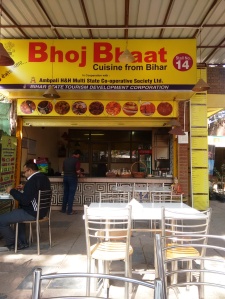
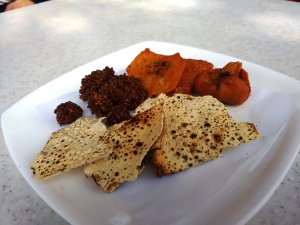
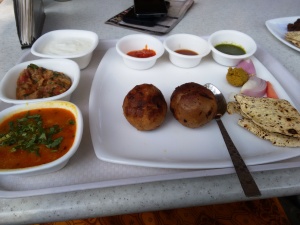

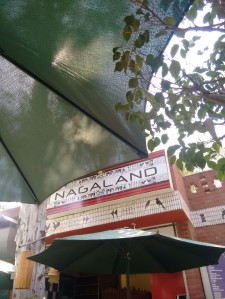
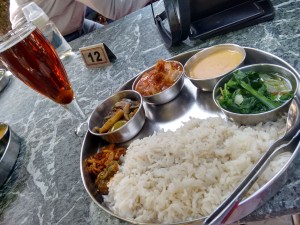



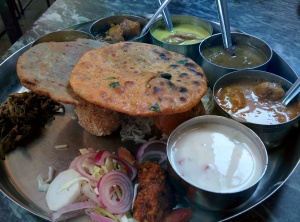
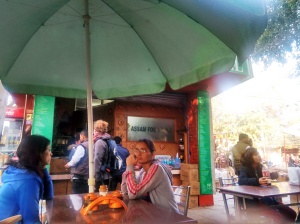
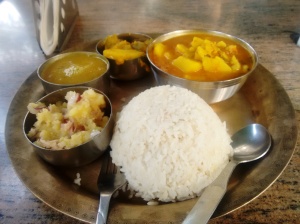
And I would go to Dilli Haat only for adda over fruit beer :) . Maybe I should try out something you have mentioned the next time I am there. Been there last in 2009.
Coming to the Bengal Dish, Bijoli Grill were very good in the late 1970s and the early 1980s. Now they are also non-existent in Calcutta as the quality has gone down considerably. Payesh sweetened with jaggery should have been there though. Jaggery (best quality is Nalen Gur) is used extensively in Bengal during the winter for Rosogolla, Kanchagolla, various types of Sandesh, Rosomalai and of course payesh, both simui and the rice variety.
LikeLike
Anirudha, I do wish you wouldn’t mention all those gorgeous Bengali sweets! I don’t usually like Indian sweets, but stuff like nolen gurer payesh, sandesh and rosomalai… just the thought of them makes me want to have some!
The first time I remember eating Bijoli Grill food was at my sister’s wedding reception, in the very early 1990s. Bijoli Grill didn’t have an establishment in Delhi back then, but her father-in-law hired them from Cal to come to Delhi to cater for the reception. I thought the food was very good, but looking back, I have to admit it was pretty much a case of bandar kya jaane adrak ka swaad.
LikeLike
Bijoli Grill was good then. I would say reasonable. Gradually, it failed to sustain the momentum..maybe success had gone into the head of the owners. With competition, esp from the unorganized sector,it lost the edge.
Be my guest when you are in Calcutta, I can treat you to the best sweets :).
LikeLike
“Be my guest when you are in Calcutta, I can treat you to the best sweets :).”
:-D Yay! I will keep that in mind and ask your for recommendations the next time I’m there.
LikeLike
Not fair! It is 5 PM and I am really hungry. I have been slurping through your descriptions. Time to send a link to Harvey!
LikeLike
:-) You are to blame, a little, for this post, Ava! Do you remember, many months back, you posted (on PKK) a link to an article on India’s best thalis? That was what inspired me to try this – and now I’m seriously considering going and checking out the thalis (wherever offered) of all the other food stalls at Dilli Haat!
LikeLiked by 1 person
You should. I am already planning on trying on or two the next time I am in Delhi.
I have never eaten Rajasthani food. :) Will surely try that.
LikeLike
Rajasthani food, though it has a few meat dishes (laal maas and safed maas, notably) is best-known for its vegetarian dishes, Ava. And they can be really, really good. I remember, many years ago, Tarun and I visited Shekhavati and spent a couple of days staying at a Neemrana property (the Piramal Haveli), where all the food they served as vegetarian Marwari stuff. It was simply unforgettable – we still remember it fondly. :-)
LikeLiked by 1 person
Haan, I am happy to try out Vegetarian dishes. :)
LikeLike
Echoing Ava. Not fair – I’m hungry (even if I’m vegetarian)! :) We went to Dilli Haat in 2008; got a lovely skirt there. And yes, ate there too, though I don’t remember at which stall.
LikeLike
Dilli Haat does have some wonderful things to buy – though, sadly, over the past few years, it’s become more predictable, with the same stall-holders coming over and over again. Still lots of good things to buy, but the range is somewhat less extensive than it used to be. But the food. :-)… and so many vegetarian options, too, actually.
LikeLike
Madhu thanks for this delicious visit, which has reminded me of my stays there, and really tugged at me to come back to Delhi. I kept reading and telling myself how lucky she is to be able to have all this great food ready-made for her! Sigh, I don’t know when I’m back though. The only thing which grieves me is the Delhi pollution: is it still very bad? Does it affect you? Do you think about it when you have to go out? Last October it was again so bad I came back with this same strange sore throat…
Anyway, lots of good vibes coming to you!
yves
LikeLike
Yves, thank you for commenting! Yes, the pollution in Delhi has gone from bad to worse. This year, for instance, we’ve all had – as a family – three bouts of the flu, complete with coughs, colds and fever – over the course of the winter. Fortunately, the Delhi government does seem to be trying to do something to help – by implementing the odd-even rule for private vehicles, for instance – but while that helps reduce the traffic and pollution to some extent, the fact of the matter is that Delhi’s public transport system isn’t good enough for that to be a viable alternative. Since I work from home and rarely need to go out, it doesn’t make too much of a difference to me, but my husband knows how horrible it is…
Thank you for the good vibes. :-) I need them! Hope you’re well.
LikeLike
Thank you for reminding about the food at dilli haat. It has been years since I last visited and still remember the delicious bhel we had. I would love to try sattu paratha and makhane ki kheer. I have not had the kheer since my mom passed away, hers was so good. The only problem in trying different foods in Delhi is that our immune system ( mine at least) has weekend substantially over the years living in US. I miss the ethnic foods of home. Will brave it and try next time.
LikeLike
Yes, I can understand that long absences from Indian food (by which I mean, cooked in India, and not ghar ka khaana) can be a problem if you want to try out local dishes when you’re visiting here. Maybe once you’ve spent a few days here, and dosing yourself liberally on probiotics…?
The sattu parathas and makhaane ki kheer were really, really nice. The last time i had makhaane ki kheer was at my parents’ – my mother made it – and this was every bit as good.
LikeLike
Next time I am coming with you – I just took photos of all the wonderful menus.
Confess I had a chhole-bhature while my friend went for a wonderful Burmese soup (not the common one, another ramen-like thing). My excuse is that I hadn’t had my chhole bhature fix of the trip..
LikeLike
I can understand, Bawa! Just last weekend, I was feeling too lazy to cook, so we decided to order in. And I, looking through the stacks of home delivery menus in my desk, suddenly had this craving for chhole-bhature. it turned out greasy (well, bhature aren’t really the best thing to be packed) and the chhole were very oily as well, but still. I needed them. :-)
Yes, next time you’re in town, we’ll put a Dilli Haat trip on the agenda!
LikeLike
Gosh! Where have I been? I ask myself. Guess what I just now noticed that my last post on my food blog was on September 30, 2015. I couldn’t believe it, I wondered whether some of my later posts had just vanished but no, I did not post anything after that.
I was busy, there were some health issues and it was not just me with the health problems it was my comp. too. On my brother’s suggestion I decided to upgrade to Windows 10. I have been regretting my decision ever since. It is an old wine in a new bottle and for the life of me I cannot figure how to tackle this new bottle. I must have clicked something somewhere and I am now not able to log onto anything without being bombarded by ads, I was unable to post comments on either your blog or Anu’s blog- the only two blogs I take out time to visit. Now I am using my brother’s comp.
OK enough of my sob story. Your post brings back sweet memories of my visit to Dilli Haat and Bijoli Grill. I had done a post about it in my blog. We had some delicious fish dishes like chittol maacher muitha. This was much better than OH Calcutta’s actually no – describing it as much better would be absolutely wrong. The latter’s fish was rubbery.
LikeLike
Welcome back, Shilpi! So good to have you back. I was wondering whether all was well, or if you were just too busy. Sad to hear of all the problems you’ve been having with your computer – have you got someone to check it out?
As for your blog post on Bijoli Grill, yes – I did remember it! In fact, I had gone to Dilli Haat a few days after you’d published it, and your review was so fresh in my mind that I told my husband, “Let’s eat at Bijoli Grill!”
RUbbery fish?! Unforgivable. Even worse when it comes to a Bengali restaurant, which should be able to get its fish just right, every time. :-(
LikeLike
I was looking for movie songs on the spring festival when I discovered your website. But this post on Dilli Haat (never been here) has me salivating :) – my ‘to-do’ list is just getting longer!
LikeLike
Do visit and eat – I’ve been to more stalls than I’ve mentioned here, and I can vouch for the fabulousness of at least the Mizoram, Maharashtra, J&K and Kerala stalls’ food. All super!
LikeLike
Nice blog. Also check ours: https://10tips.in/2016/11/06/10-popular-local-dishes-in-rajasthan/
LikeLike
Thank you!
LikeLiked by 1 person